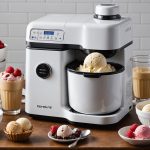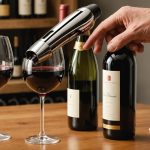Understanding UV Light Sanitizers
UV light sanitizers are revolutionizing food safety by effectively eliminating pathogens through ultraviolet radiation. Pathogens, such as bacteria and viruses, are targeted and destroyed by UV exposure, interrupting their DNA structure and preventing reproduction. This technology is not only convenient but also scientifically proven.
Research indicates that employing UV light sanitizers in food safety settings significantly reduces microbial contamination. Various studies support the effectiveness of UV technology, demonstrating its capacity to enhance safety in food preparation environments. Notably, UV light is employed in many industries to ensure cleanliness, particularly where maintaining hygiene standards is critical.
Also to read : Transform your cooking experience: discover how adjustable lighting in range hoods enhances health for mindful chefs
In addition to food safety advantages, the impact of sanitization on nutritional quality is vital. Unlike some traditional methods, UV sanitization operates without the introduction of chemicals that might degrade nutrients. Therefore, the nutritional value of food is preserved, maintaining its integrity and beneficial properties. However, it is essential to use UV light sanitizers appropriately to harness their full potential without compromising food quality.
While UV light sanitizers prove effective, understanding their operation and impact is imperative in utilizing them to maximize food safety and nutrient retention.
Topic to read : Revitalize your kitchen: pro tips for creating a chic slimming tea and coffee corner
Benefits of Using UV Light Sanitizers in the Kitchen
UV light sanitizers offer numerous advantages in the kitchen compared to traditional cleaning methods. Their primary benefit is their ability to reduce cross-contamination risks during food preparation. Unlike chemical sanitizers, UV light does not leave residues that might taint food flavors or pose allergies. This results in a cleaner kitchen environment, effectively lowering the chances of pathogen transmission.
One of the standout benefits is the enhancement of nutrition in fruits and vegetables. UV light sanitizers maintain the integrity and nutritional value of produce by eliminating harmful pathogens without degrading essential vitamins and minerals. This natural preservation method ensures that food remains wholesome, contributing positively to the daily dietary needs of a household.
In contrast, traditional methods often require harsh chemicals, which can be abrasive and result in nutrient loss in sensitive foods. Additionally, UV light sanitizers are a more sustainable option. They consume less water and create no chemical waste, aligning with a more environmentally friendly approach to kitchen hygiene. These advantages make UV light sanitizers an appealing choice for enhancing both kitchen safety and nutritional quality.
Safety Considerations When Using UV Light Sanitizers
When integrating UV light sanitizers into your kitchen, it’s crucial to adhere to certain safety tips to prevent potential health issues. UV light, while effective, can be hazardous if not used correctly. Direct exposure to the skin and eyes should be avoided as it may lead to severe burns or eye injury. This is a frequent mistake among users, and understanding its risks is essential.
Before activating the sanitizer, ensure that all packaging and food are arranged so the UV light reaches every part effectively, minimizing exposure risks. Equally important is the application of protective measures like reflective shields or enclosures to confine the light, reducing any unintended exposure to humans.
Lastly, the surrounding environment should be well-ventilated. Although UV sanitizers do not emit harmful substances, ensuring airflow further reduces any unlikely build-up of pathogens or physical discomfort, creating a more sterile and comfortable kitchen setting. Awareness and understanding here protect both you and others from accidental injuries often overlooked in the excitement of using this cutting-edge technology for better hygiene and sanitation.
Best Practices for Using UV Light Sanitizers
Successfully incorporating UV light sanitizers into your kitchen involves following certain best practices to achieve optimal kitchen hygiene. The correct placement of these devices is crucial. Ensure they are positioned where UV light can cover the maximum area, particularly on surfaces where food is commonly prepared. Proper placement not only enhances effectiveness but also ensures consistent microbial control.
Proper Placement and Usage
For effective UV light usage, place the sanitizer in positions where light reaches shadowed zones, ensuring uniform exposure. This minimizes the risk of pathogens surviving on unequally treated areas and contributes to an overall sanitary environment.
Duration of Exposure
The recommended duration of exposure varies; however, most UV sanitization processes suggest a minimum of 10 to 15 minutes. This ensures adequate time for the UV light to neutralize bacterial and viral threats without risking nutritional degradation of food items.
Reflective Surfaces in Kitchen
Incorporating reflective surfaces can significantly bolster the sanitization process. Mirrors or reflective shields distribute UV rays more evenly, penetrating awkward angles and maximizing pathogen elimination. These surfaces complement the sanitizer’s functionality, thus maintaining kitchen cleanliness and hygiene standards.
Preserving Nutritional Value During Sanitization
Maintaining nutritional value is essential in food sanitization. UV light sanitizers offer a solution that preserves nutrients while ensuring food quality. Unlike methods involving chemicals, which may degrade nutrients, UV sanitization interacts at the microbial level, effectively targeting pathogens without altering the food’s core components.
Mechanisms of Nutrient Preservation
Nutrient retention is achieved as UV light sanitizers function without heat or chemicals. This process allows food to remain unaltered, preserving its beneficial properties. It focuses specifically on affecting microbial DNA, which means that vitamins and minerals stay intact.
Recommendations for Food Quality
To maximize food quality while sanitizing, it’s vital to adhere to proper exposure guidelines. Recommendations include using the UV light for its suggested duration, ensuring that the sanitization effectively targets pathogens without compromising integrity. Rotate food items to allow even exposure and prevent any missed areas that could harbor microbes.
Role in Enhancing Safety
UV sanitization not only excels in nutrient maintenance but also enhances safety by reducing pathogen presence effectively. This dual benefit makes it a preferred method in settings where both food quality and safety are priorities, ensuring a healthier, tastier outcome.
Comparing UV Light Sanitizers with Traditional Methods
When considering sanitization methods, significant differences arise between UV light sanitizers and traditional chemical approaches. UV sanitization excels by avoiding chemical residues—a common issue with chemical methods—thereby preserving food flavors and reducing allergy risks. This key difference enhances food quality in kitchens and other food preparation settings while lowering potential health hazards.
UV light sanitizers are advantageous for their efficacy in pathogen elimination without compromising food safety. Case studies have shown successful transitions where industries reduced microbial contamination, highlighting the practical benefits of UV technology. For example, in hospital kitchen environments, UV systems dramatically decreased infection rates.
Yet, it’s not all beneficial. Chemical sanitizers might penetrate crevices where UV light struggles. They can more easily handle heavily soiled surfaces as opposed to UV light, which primarily requires a clean, unobstructed path to be effective.
Pros of UV sanitizers include preserving nutritional integrity and offering a chemical-free solution. However, cons exist, such as potential effectiveness limitations in shadowed areas. Making an informed decision involves weighing these factors, emphasizing how crucial it is to align the method with specific needs for optimal kitchen hygiene.
Product Reviews of Popular UV Light Sanitizers
In the ever-evolving market of UV light sanitizers, some brands have emerged as industry leaders. When choosing the best UV light sanitizers for kitchens, it is essential to consider distinct features and specifications of each product to determine the most suitable option for your needs.
Top Recommended Brands
Reputable brands like XYZ Sanitizers and UVSafe lead the pack with their innovative designs and reliable performance. These brands have garnered positive feedback for their durability and effectiveness in reducing pathogens in kitchen settings.
Unique Features and Specifications
Various models boast unique features such as automatic shut-off, 360-degree coverage, and quick sanitization cycles, enhancing both convenience and efficiency. The UV intensity in these devices is regulated to ensure maximum safety and effective microorganism elimination without damaging surfaces or food quality.
User Feedback and Performance
Consumer reviews highlight user satisfaction with the ease of use and visible improvements in kitchen cleanliness. Many users note a decrease in foodborne illness incidents, attributing this improvement to diligent use of these sanitizers. Frequent commendations also point to the longevity and consistent performance of devices from well-rated brands, securing their position as trusted kitchen products.











